Kenyatta University: ADR's Role in Kenyan MFIs' Challenges
VerifiedAdded on 2023/06/08
|39
|9956
|288
Thesis and Dissertation
AI Summary
This research paper, submitted in partial fulfillment of a Bachelor of Laws degree at Kenyatta University, investigates the efficacy of Alternative Dispute Resolution (ADR) in addressing challenges faced by Microfinance Institutions (MFIs) in Kenya. The study explores how ADR can mitigate poverty by resolving disputes, lowering loan defaults, increasing operational efficiency, and ensuring regulatory compliance. Employing a mixed-methods approach, including case studies and stakeholder interviews, the paper examines the legal and institutional frameworks surrounding ADR in Kenya, comparing its application with other countries and analyzing the barriers to its implementation. The findings highlight ADR's effectiveness in the microfinance sector, recommending its integration into MFI dispute resolution procedures as a practical alternative to traditional litigation. The research identifies challenges such as data accessibility, limited sample size, and potential biases, while also emphasizing the need for clear legal norms and stakeholder acceptance to enhance ADR's effectiveness in resolving disputes and promoting financial inclusion.
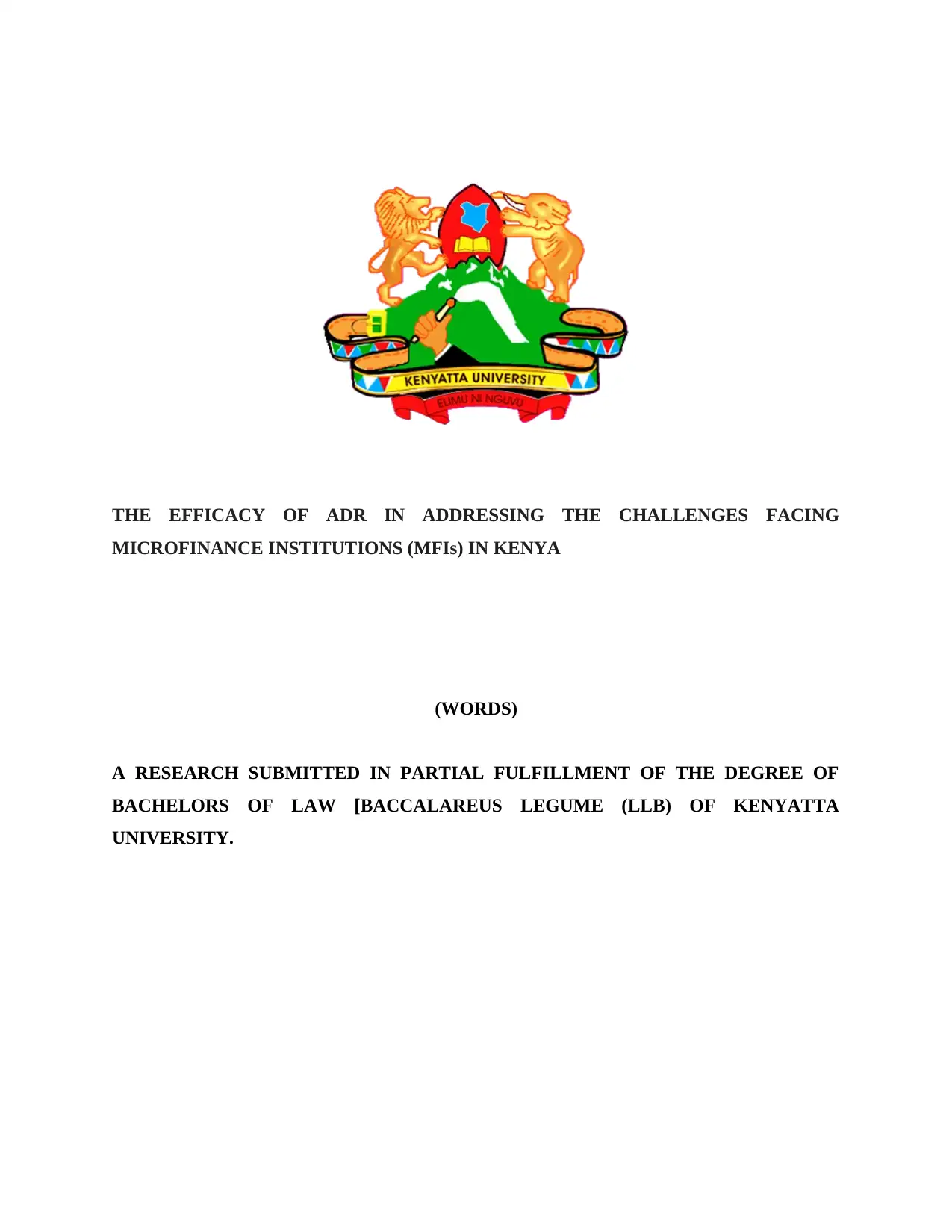
THE EFFICACY OF ADR IN ADDRESSING THE CHALLENGES FACING
MICROFINANCE INSTITUTIONS (MFIs) IN KENYA
(WORDS)
A RESEARCH SUBMITTED IN PARTIAL FULFILLMENT OF THE DEGREE OF
BACHELORS OF LAW [BACCALAREUS LEGUME (LLB) OF KENYATTA
UNIVERSITY.
MICROFINANCE INSTITUTIONS (MFIs) IN KENYA
(WORDS)
A RESEARCH SUBMITTED IN PARTIAL FULFILLMENT OF THE DEGREE OF
BACHELORS OF LAW [BACCALAREUS LEGUME (LLB) OF KENYATTA
UNIVERSITY.
Paraphrase This Document
Need a fresh take? Get an instant paraphrase of this document with our AI Paraphraser
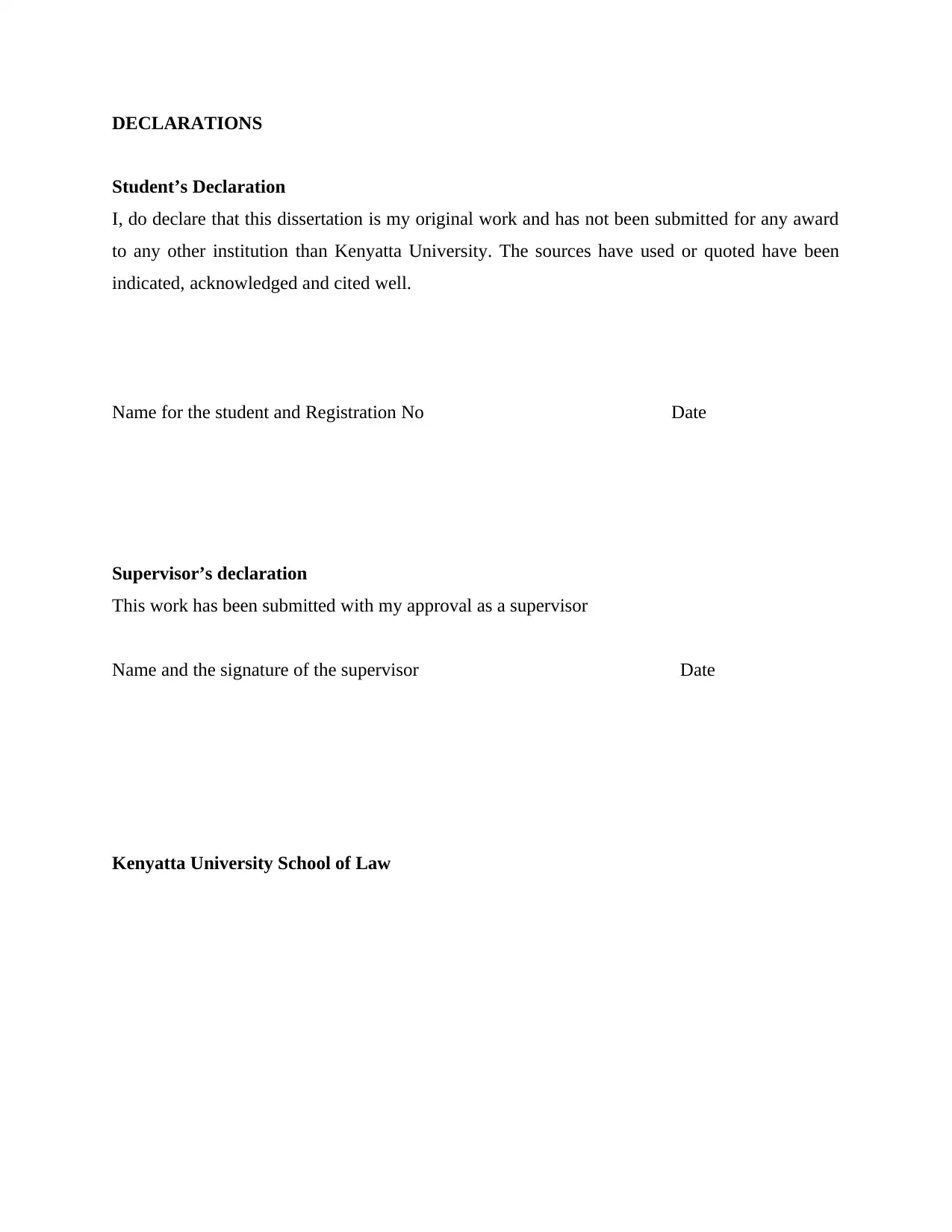
DECLARATIONS
Student’s Declaration
I, do declare that this dissertation is my original work and has not been submitted for any award
to any other institution than Kenyatta University. The sources have used or quoted have been
indicated, acknowledged and cited well.
Name for the student and Registration No Date
Supervisor’s declaration
This work has been submitted with my approval as a supervisor
Name and the signature of the supervisor Date
Kenyatta University School of Law
Student’s Declaration
I, do declare that this dissertation is my original work and has not been submitted for any award
to any other institution than Kenyatta University. The sources have used or quoted have been
indicated, acknowledged and cited well.
Name for the student and Registration No Date
Supervisor’s declaration
This work has been submitted with my approval as a supervisor
Name and the signature of the supervisor Date
Kenyatta University School of Law

DEDICATION
⊘ This is a preview!⊘
Do you want full access?
Subscribe today to unlock all pages.

Trusted by 1+ million students worldwide
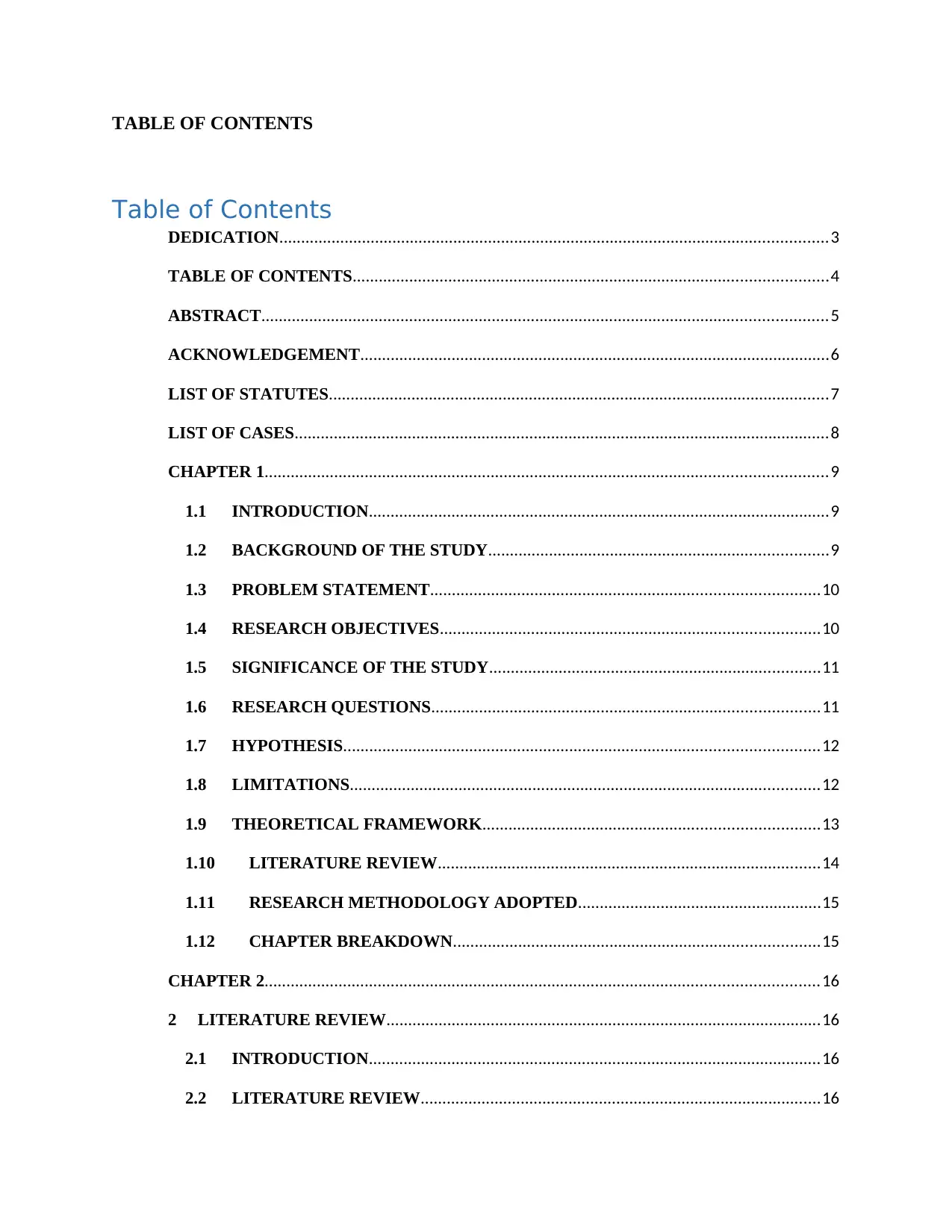
TABLE OF CONTENTS
Table of Contents
DEDICATION..............................................................................................................................3
TABLE OF CONTENTS.............................................................................................................4
ABSTRACT..................................................................................................................................5
ACKNOWLEDGEMENT............................................................................................................6
LIST OF STATUTES...................................................................................................................7
LIST OF CASES...........................................................................................................................8
CHAPTER 1.................................................................................................................................9
1.1 INTRODUCTION..........................................................................................................9
1.2 BACKGROUND OF THE STUDY..............................................................................9
1.3 PROBLEM STATEMENT.........................................................................................10
1.4 RESEARCH OBJECTIVES.......................................................................................10
1.5 SIGNIFICANCE OF THE STUDY............................................................................11
1.6 RESEARCH QUESTIONS.........................................................................................11
1.7 HYPOTHESIS.............................................................................................................12
1.8 LIMITATIONS............................................................................................................12
1.9 THEORETICAL FRAMEWORK.............................................................................13
1.10 LITERATURE REVIEW........................................................................................14
1.11 RESEARCH METHODOLOGY ADOPTED........................................................15
1.12 CHAPTER BREAKDOWN....................................................................................15
CHAPTER 2...............................................................................................................................16
2 LITERATURE REVIEW....................................................................................................16
2.1 INTRODUCTION........................................................................................................16
2.2 LITERATURE REVIEW............................................................................................16
Table of Contents
DEDICATION..............................................................................................................................3
TABLE OF CONTENTS.............................................................................................................4
ABSTRACT..................................................................................................................................5
ACKNOWLEDGEMENT............................................................................................................6
LIST OF STATUTES...................................................................................................................7
LIST OF CASES...........................................................................................................................8
CHAPTER 1.................................................................................................................................9
1.1 INTRODUCTION..........................................................................................................9
1.2 BACKGROUND OF THE STUDY..............................................................................9
1.3 PROBLEM STATEMENT.........................................................................................10
1.4 RESEARCH OBJECTIVES.......................................................................................10
1.5 SIGNIFICANCE OF THE STUDY............................................................................11
1.6 RESEARCH QUESTIONS.........................................................................................11
1.7 HYPOTHESIS.............................................................................................................12
1.8 LIMITATIONS............................................................................................................12
1.9 THEORETICAL FRAMEWORK.............................................................................13
1.10 LITERATURE REVIEW........................................................................................14
1.11 RESEARCH METHODOLOGY ADOPTED........................................................15
1.12 CHAPTER BREAKDOWN....................................................................................15
CHAPTER 2...............................................................................................................................16
2 LITERATURE REVIEW....................................................................................................16
2.1 INTRODUCTION........................................................................................................16
2.2 LITERATURE REVIEW............................................................................................16
Paraphrase This Document
Need a fresh take? Get an instant paraphrase of this document with our AI Paraphraser
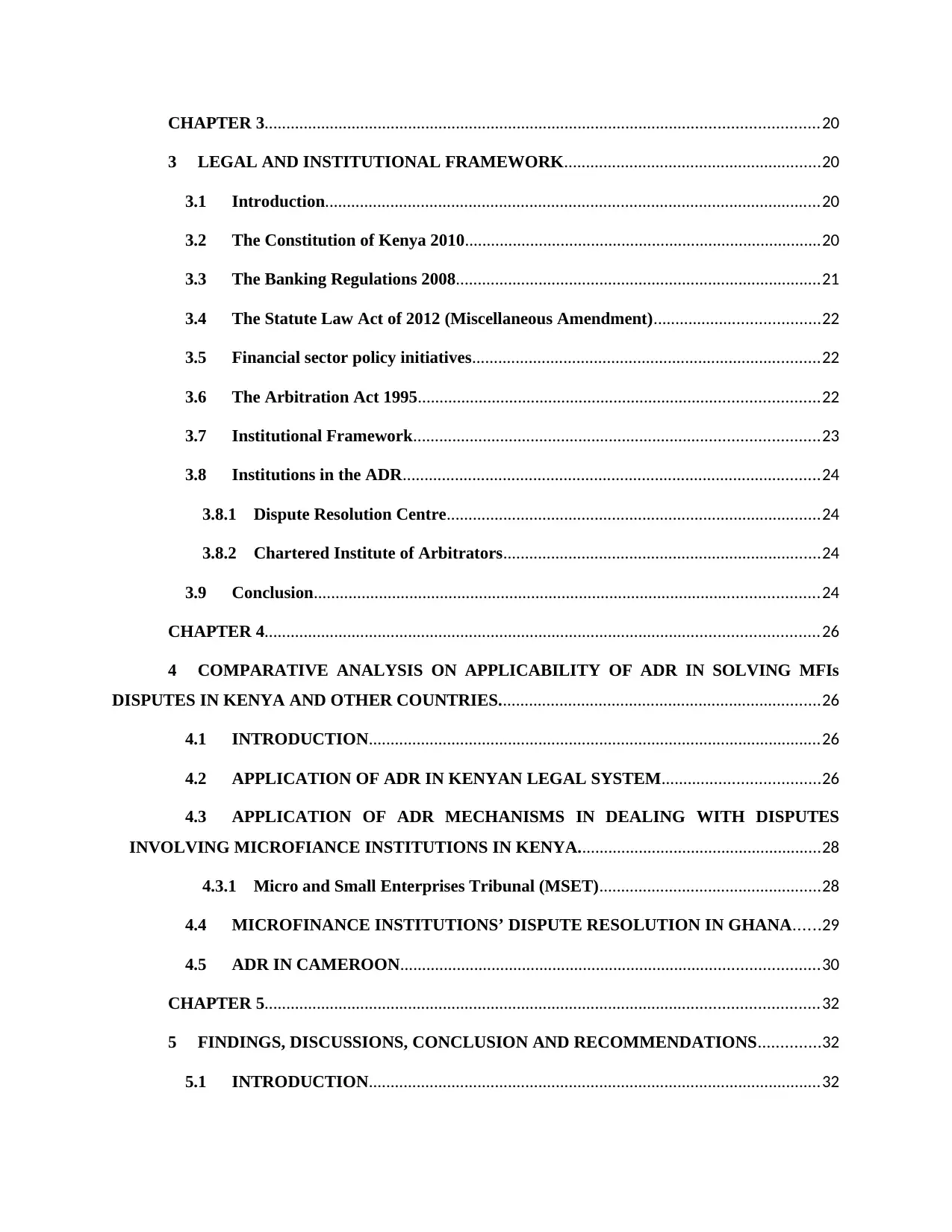
CHAPTER 3...............................................................................................................................20
3 LEGAL AND INSTITUTIONAL FRAMEWORK...........................................................20
3.1 Introduction..................................................................................................................20
3.2 The Constitution of Kenya 2010..................................................................................20
3.3 The Banking Regulations 2008....................................................................................21
3.4 The Statute Law Act of 2012 (Miscellaneous Amendment)......................................22
3.5 Financial sector policy initiatives................................................................................22
3.6 The Arbitration Act 1995............................................................................................22
3.7 Institutional Framework.............................................................................................23
3.8 Institutions in the ADR................................................................................................24
3.8.1 Dispute Resolution Centre......................................................................................24
3.8.2 Chartered Institute of Arbitrators.........................................................................24
3.9 Conclusion....................................................................................................................24
CHAPTER 4...............................................................................................................................26
4 COMPARATIVE ANALYSIS ON APPLICABILITY OF ADR IN SOLVING MFIs
DISPUTES IN KENYA AND OTHER COUNTRIES..........................................................................26
4.1 INTRODUCTION........................................................................................................26
4.2 APPLICATION OF ADR IN KENYAN LEGAL SYSTEM....................................26
4.3 APPLICATION OF ADR MECHANISMS IN DEALING WITH DISPUTES
INVOLVING MICROFIANCE INSTITUTIONS IN KENYA........................................................28
4.3.1 Micro and Small Enterprises Tribunal (MSET)...................................................28
4.4 MICROFINANCE INSTITUTIONS’ DISPUTE RESOLUTION IN GHANA......29
4.5 ADR IN CAMEROON................................................................................................30
CHAPTER 5...............................................................................................................................32
5 FINDINGS, DISCUSSIONS, CONCLUSION AND RECOMMENDATIONS..............32
5.1 INTRODUCTION........................................................................................................32
3 LEGAL AND INSTITUTIONAL FRAMEWORK...........................................................20
3.1 Introduction..................................................................................................................20
3.2 The Constitution of Kenya 2010..................................................................................20
3.3 The Banking Regulations 2008....................................................................................21
3.4 The Statute Law Act of 2012 (Miscellaneous Amendment)......................................22
3.5 Financial sector policy initiatives................................................................................22
3.6 The Arbitration Act 1995............................................................................................22
3.7 Institutional Framework.............................................................................................23
3.8 Institutions in the ADR................................................................................................24
3.8.1 Dispute Resolution Centre......................................................................................24
3.8.2 Chartered Institute of Arbitrators.........................................................................24
3.9 Conclusion....................................................................................................................24
CHAPTER 4...............................................................................................................................26
4 COMPARATIVE ANALYSIS ON APPLICABILITY OF ADR IN SOLVING MFIs
DISPUTES IN KENYA AND OTHER COUNTRIES..........................................................................26
4.1 INTRODUCTION........................................................................................................26
4.2 APPLICATION OF ADR IN KENYAN LEGAL SYSTEM....................................26
4.3 APPLICATION OF ADR MECHANISMS IN DEALING WITH DISPUTES
INVOLVING MICROFIANCE INSTITUTIONS IN KENYA........................................................28
4.3.1 Micro and Small Enterprises Tribunal (MSET)...................................................28
4.4 MICROFINANCE INSTITUTIONS’ DISPUTE RESOLUTION IN GHANA......29
4.5 ADR IN CAMEROON................................................................................................30
CHAPTER 5...............................................................................................................................32
5 FINDINGS, DISCUSSIONS, CONCLUSION AND RECOMMENDATIONS..............32
5.1 INTRODUCTION........................................................................................................32
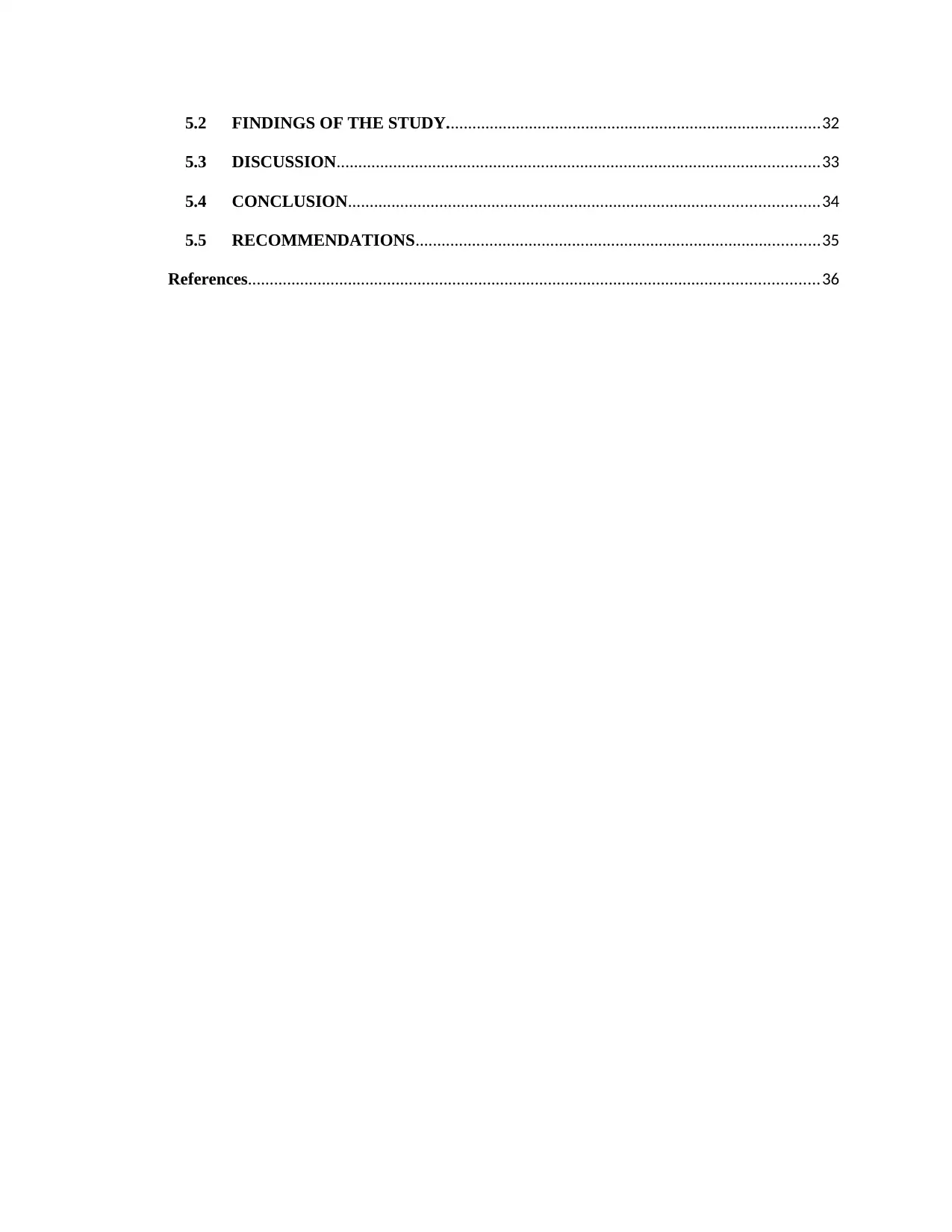
5.2 FINDINGS OF THE STUDY......................................................................................32
5.3 DISCUSSION...............................................................................................................33
5.4 CONCLUSION............................................................................................................34
5.5 RECOMMENDATIONS.............................................................................................35
References...................................................................................................................................36
5.3 DISCUSSION...............................................................................................................33
5.4 CONCLUSION............................................................................................................34
5.5 RECOMMENDATIONS.............................................................................................35
References...................................................................................................................................36
⊘ This is a preview!⊘
Do you want full access?
Subscribe today to unlock all pages.

Trusted by 1+ million students worldwide
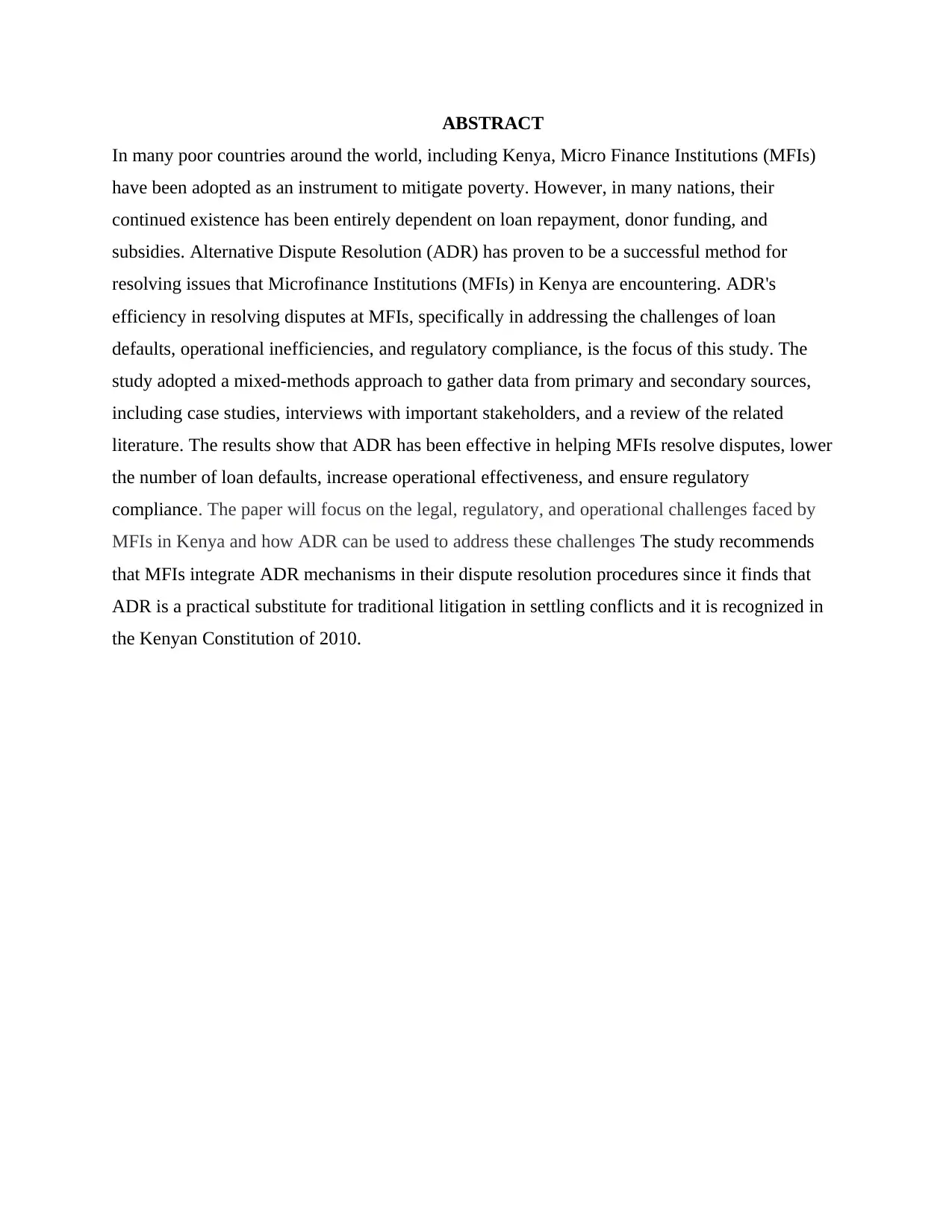
ABSTRACT
In many poor countries around the world, including Kenya, Micro Finance Institutions (MFIs)
have been adopted as an instrument to mitigate poverty. However, in many nations, their
continued existence has been entirely dependent on loan repayment, donor funding, and
subsidies. Alternative Dispute Resolution (ADR) has proven to be a successful method for
resolving issues that Microfinance Institutions (MFIs) in Kenya are encountering. ADR's
efficiency in resolving disputes at MFIs, specifically in addressing the challenges of loan
defaults, operational inefficiencies, and regulatory compliance, is the focus of this study. The
study adopted a mixed-methods approach to gather data from primary and secondary sources,
including case studies, interviews with important stakeholders, and a review of the related
literature. The results show that ADR has been effective in helping MFIs resolve disputes, lower
the number of loan defaults, increase operational effectiveness, and ensure regulatory
compliance. The paper will focus on the legal, regulatory, and operational challenges faced by
MFIs in Kenya and how ADR can be used to address these challenges The study recommends
that MFIs integrate ADR mechanisms in their dispute resolution procedures since it finds that
ADR is a practical substitute for traditional litigation in settling conflicts and it is recognized in
the Kenyan Constitution of 2010.
In many poor countries around the world, including Kenya, Micro Finance Institutions (MFIs)
have been adopted as an instrument to mitigate poverty. However, in many nations, their
continued existence has been entirely dependent on loan repayment, donor funding, and
subsidies. Alternative Dispute Resolution (ADR) has proven to be a successful method for
resolving issues that Microfinance Institutions (MFIs) in Kenya are encountering. ADR's
efficiency in resolving disputes at MFIs, specifically in addressing the challenges of loan
defaults, operational inefficiencies, and regulatory compliance, is the focus of this study. The
study adopted a mixed-methods approach to gather data from primary and secondary sources,
including case studies, interviews with important stakeholders, and a review of the related
literature. The results show that ADR has been effective in helping MFIs resolve disputes, lower
the number of loan defaults, increase operational effectiveness, and ensure regulatory
compliance. The paper will focus on the legal, regulatory, and operational challenges faced by
MFIs in Kenya and how ADR can be used to address these challenges The study recommends
that MFIs integrate ADR mechanisms in their dispute resolution procedures since it finds that
ADR is a practical substitute for traditional litigation in settling conflicts and it is recognized in
the Kenyan Constitution of 2010.
Paraphrase This Document
Need a fresh take? Get an instant paraphrase of this document with our AI Paraphraser

ACKNOWLEDGEMENT
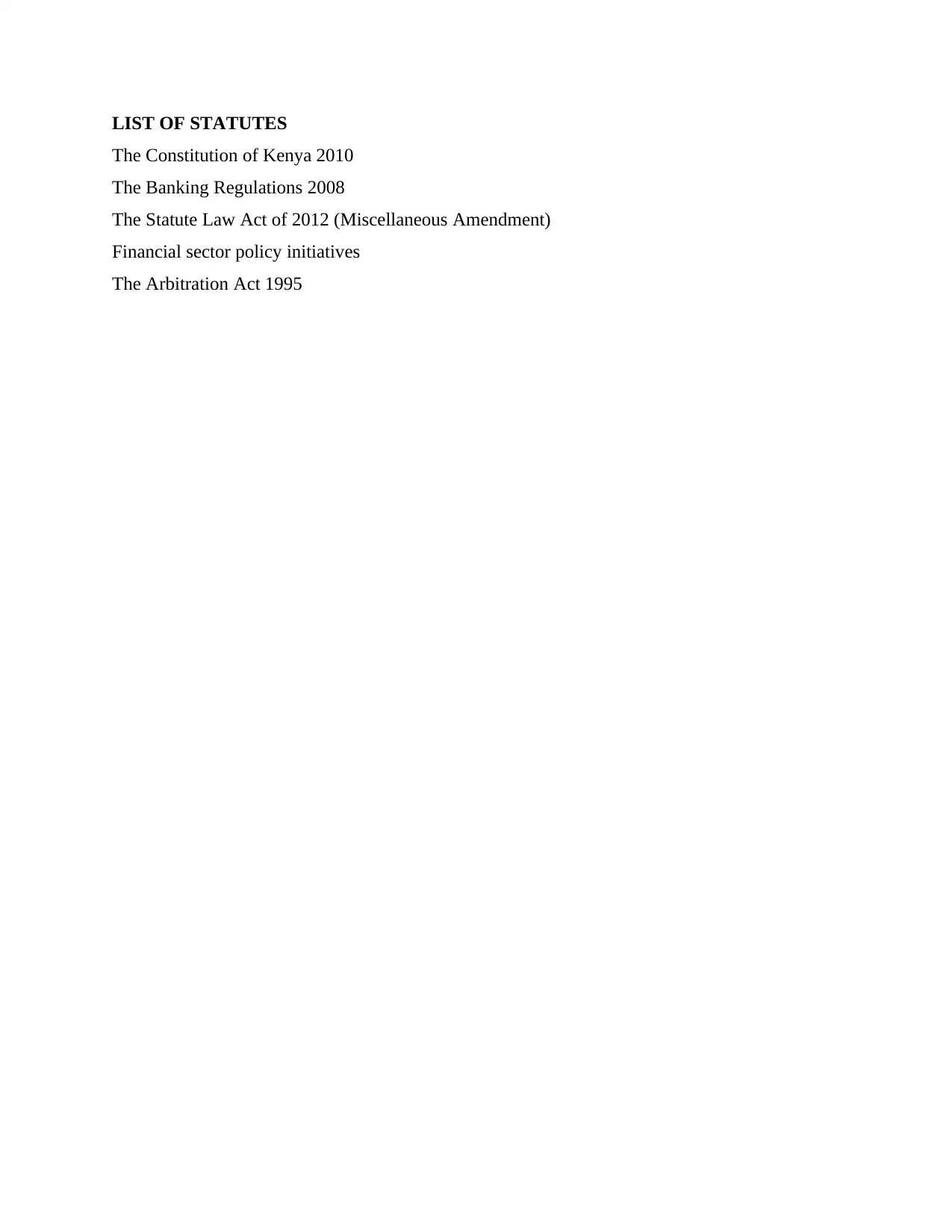
LIST OF STATUTES
The Constitution of Kenya 2010
The Banking Regulations 2008
The Statute Law Act of 2012 (Miscellaneous Amendment)
Financial sector policy initiatives
The Arbitration Act 1995
The Constitution of Kenya 2010
The Banking Regulations 2008
The Statute Law Act of 2012 (Miscellaneous Amendment)
Financial sector policy initiatives
The Arbitration Act 1995
⊘ This is a preview!⊘
Do you want full access?
Subscribe today to unlock all pages.

Trusted by 1+ million students worldwide
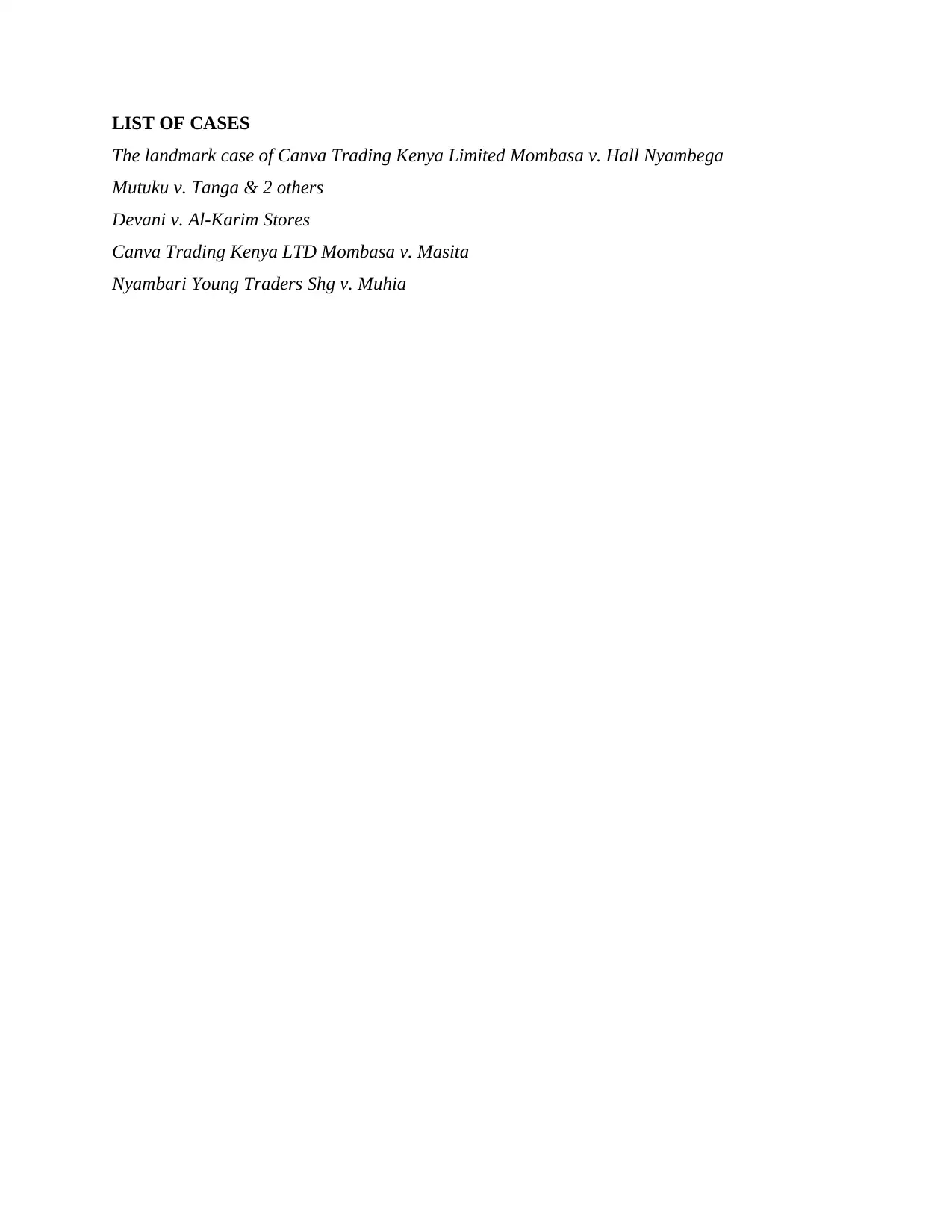
LIST OF CASES
The landmark case of Canva Trading Kenya Limited Mombasa v. Hall Nyambega
Mutuku v. Tanga & 2 others
Devani v. Al-Karim Stores
Canva Trading Kenya LTD Mombasa v. Masita
Nyambari Young Traders Shg v. Muhia
The landmark case of Canva Trading Kenya Limited Mombasa v. Hall Nyambega
Mutuku v. Tanga & 2 others
Devani v. Al-Karim Stores
Canva Trading Kenya LTD Mombasa v. Masita
Nyambari Young Traders Shg v. Muhia
Paraphrase This Document
Need a fresh take? Get an instant paraphrase of this document with our AI Paraphraser
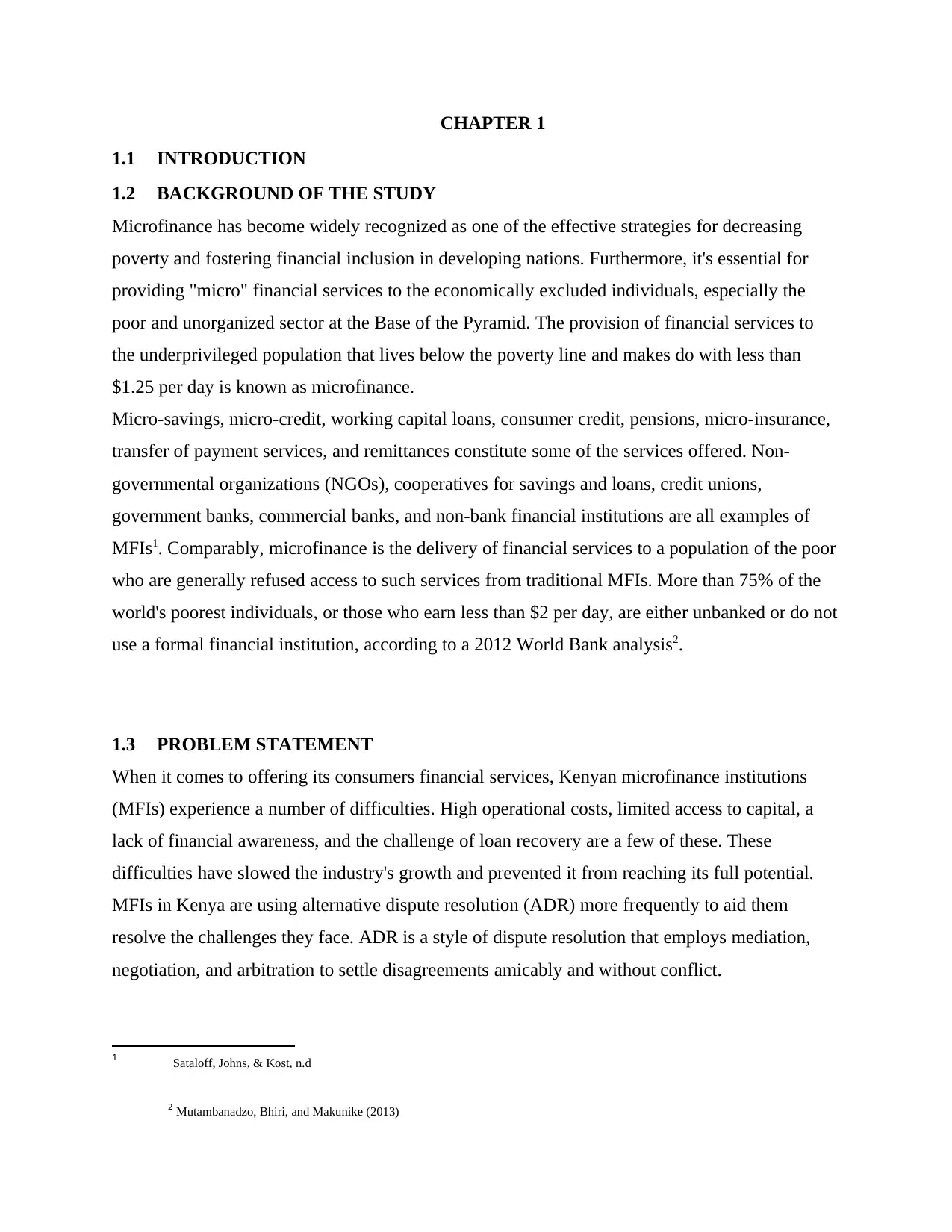
CHAPTER 1
1.1 INTRODUCTION
1.2 BACKGROUND OF THE STUDY
Microfinance has become widely recognized as one of the effective strategies for decreasing
poverty and fostering financial inclusion in developing nations. Furthermore, it's essential for
providing "micro" financial services to the economically excluded individuals, especially the
poor and unorganized sector at the Base of the Pyramid. The provision of financial services to
the underprivileged population that lives below the poverty line and makes do with less than
$1.25 per day is known as microfinance.
Micro-savings, micro-credit, working capital loans, consumer credit, pensions, micro-insurance,
transfer of payment services, and remittances constitute some of the services offered. Non-
governmental organizations (NGOs), cooperatives for savings and loans, credit unions,
government banks, commercial banks, and non-bank financial institutions are all examples of
MFIs1. Comparably, microfinance is the delivery of financial services to a population of the poor
who are generally refused access to such services from traditional MFIs. More than 75% of the
world's poorest individuals, or those who earn less than $2 per day, are either unbanked or do not
use a formal financial institution, according to a 2012 World Bank analysis2.
1.3 PROBLEM STATEMENT
When it comes to offering its consumers financial services, Kenyan microfinance institutions
(MFIs) experience a number of difficulties. High operational costs, limited access to capital, a
lack of financial awareness, and the challenge of loan recovery are a few of these. These
difficulties have slowed the industry's growth and prevented it from reaching its full potential.
MFIs in Kenya are using alternative dispute resolution (ADR) more frequently to aid them
resolve the challenges they face. ADR is a style of dispute resolution that employs mediation,
negotiation, and arbitration to settle disagreements amicably and without conflict.
1 Sataloff, Johns, & Kost, n.d
2 Mutambanadzo, Bhiri, and Makunike (2013)
1.1 INTRODUCTION
1.2 BACKGROUND OF THE STUDY
Microfinance has become widely recognized as one of the effective strategies for decreasing
poverty and fostering financial inclusion in developing nations. Furthermore, it's essential for
providing "micro" financial services to the economically excluded individuals, especially the
poor and unorganized sector at the Base of the Pyramid. The provision of financial services to
the underprivileged population that lives below the poverty line and makes do with less than
$1.25 per day is known as microfinance.
Micro-savings, micro-credit, working capital loans, consumer credit, pensions, micro-insurance,
transfer of payment services, and remittances constitute some of the services offered. Non-
governmental organizations (NGOs), cooperatives for savings and loans, credit unions,
government banks, commercial banks, and non-bank financial institutions are all examples of
MFIs1. Comparably, microfinance is the delivery of financial services to a population of the poor
who are generally refused access to such services from traditional MFIs. More than 75% of the
world's poorest individuals, or those who earn less than $2 per day, are either unbanked or do not
use a formal financial institution, according to a 2012 World Bank analysis2.
1.3 PROBLEM STATEMENT
When it comes to offering its consumers financial services, Kenyan microfinance institutions
(MFIs) experience a number of difficulties. High operational costs, limited access to capital, a
lack of financial awareness, and the challenge of loan recovery are a few of these. These
difficulties have slowed the industry's growth and prevented it from reaching its full potential.
MFIs in Kenya are using alternative dispute resolution (ADR) more frequently to aid them
resolve the challenges they face. ADR is a style of dispute resolution that employs mediation,
negotiation, and arbitration to settle disagreements amicably and without conflict.
1 Sataloff, Johns, & Kost, n.d
2 Mutambanadzo, Bhiri, and Makunike (2013)
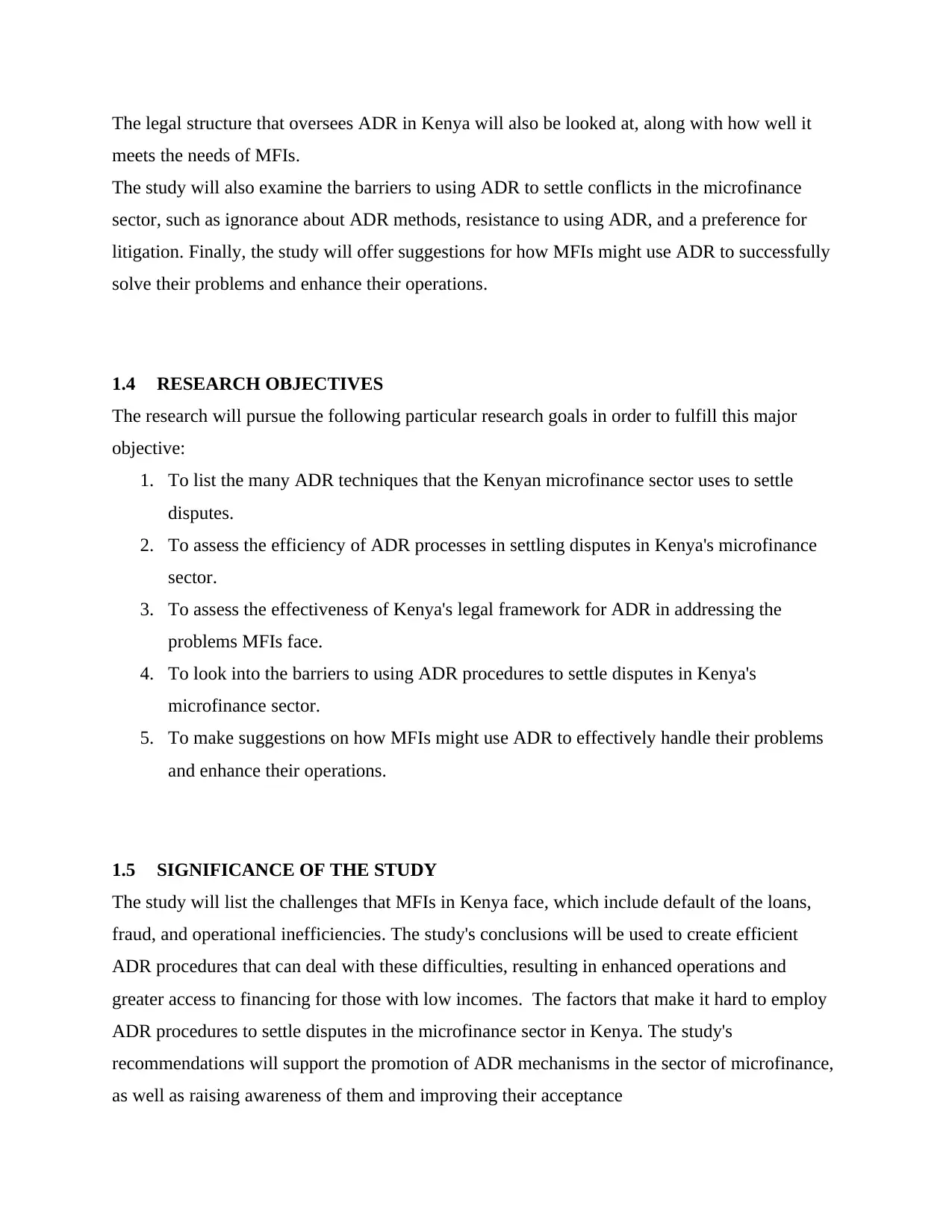
The legal structure that oversees ADR in Kenya will also be looked at, along with how well it
meets the needs of MFIs.
The study will also examine the barriers to using ADR to settle conflicts in the microfinance
sector, such as ignorance about ADR methods, resistance to using ADR, and a preference for
litigation. Finally, the study will offer suggestions for how MFIs might use ADR to successfully
solve their problems and enhance their operations.
1.4 RESEARCH OBJECTIVES
The research will pursue the following particular research goals in order to fulfill this major
objective:
1. To list the many ADR techniques that the Kenyan microfinance sector uses to settle
disputes.
2. To assess the efficiency of ADR processes in settling disputes in Kenya's microfinance
sector.
3. To assess the effectiveness of Kenya's legal framework for ADR in addressing the
problems MFIs face.
4. To look into the barriers to using ADR procedures to settle disputes in Kenya's
microfinance sector.
5. To make suggestions on how MFIs might use ADR to effectively handle their problems
and enhance their operations.
1.5 SIGNIFICANCE OF THE STUDY
The study will list the challenges that MFIs in Kenya face, which include default of the loans,
fraud, and operational inefficiencies. The study's conclusions will be used to create efficient
ADR procedures that can deal with these difficulties, resulting in enhanced operations and
greater access to financing for those with low incomes. The factors that make it hard to employ
ADR procedures to settle disputes in the microfinance sector in Kenya. The study's
recommendations will support the promotion of ADR mechanisms in the sector of microfinance,
as well as raising awareness of them and improving their acceptance
meets the needs of MFIs.
The study will also examine the barriers to using ADR to settle conflicts in the microfinance
sector, such as ignorance about ADR methods, resistance to using ADR, and a preference for
litigation. Finally, the study will offer suggestions for how MFIs might use ADR to successfully
solve their problems and enhance their operations.
1.4 RESEARCH OBJECTIVES
The research will pursue the following particular research goals in order to fulfill this major
objective:
1. To list the many ADR techniques that the Kenyan microfinance sector uses to settle
disputes.
2. To assess the efficiency of ADR processes in settling disputes in Kenya's microfinance
sector.
3. To assess the effectiveness of Kenya's legal framework for ADR in addressing the
problems MFIs face.
4. To look into the barriers to using ADR procedures to settle disputes in Kenya's
microfinance sector.
5. To make suggestions on how MFIs might use ADR to effectively handle their problems
and enhance their operations.
1.5 SIGNIFICANCE OF THE STUDY
The study will list the challenges that MFIs in Kenya face, which include default of the loans,
fraud, and operational inefficiencies. The study's conclusions will be used to create efficient
ADR procedures that can deal with these difficulties, resulting in enhanced operations and
greater access to financing for those with low incomes. The factors that make it hard to employ
ADR procedures to settle disputes in the microfinance sector in Kenya. The study's
recommendations will support the promotion of ADR mechanisms in the sector of microfinance,
as well as raising awareness of them and improving their acceptance
⊘ This is a preview!⊘
Do you want full access?
Subscribe today to unlock all pages.

Trusted by 1+ million students worldwide
1 out of 39
Related Documents
Your All-in-One AI-Powered Toolkit for Academic Success.
+13062052269
info@desklib.com
Available 24*7 on WhatsApp / Email
![[object Object]](/_next/static/media/star-bottom.7253800d.svg)
Unlock your academic potential
Copyright © 2020–2025 A2Z Services. All Rights Reserved. Developed and managed by ZUCOL.





